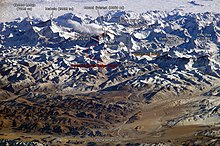
The Great Himalayas (also known as Greater Himalayas or Himadri) is one of the four parallel sub-ranges of the Himalayas.[1][2] It is the highest in altitude and extends for about 2,300 km (1,400 mi) from northern Pakistan to the Indian state of Arunachal Pradesh, passing through China, Nepal, and Bhutan. The sub-range has an average elevation of 6,100 m (20,000 ft) and contains many of the world’s tallest peaks including the eight-thousanders and Mount Everest, the highest peak on Earth.[3][4] The range is mainly composed of granite rocks with permafrost and consists of many glaciers including Gangotri, Khumbu, and Satopanth Glaciers.[5][6]
- ^ S. Sathyakumar; Mansi Mungee; Ranjana Pal (2020). "Biogeography of the Mountain Ranges of South Asia". Encyclopedia of the World's Biomes. Elsevier. pp. 543–554. ISBN 978-0-124-09548-9.
- ^ "Physiography of Himalayas". Britannica. Retrieved 1 June 2024.
- ^ Nag, Prithvish; Sengupta, Smita (1992). Geography of India. Concept Publishing. p. 40. ISBN 978-8-170-22384-9.
- ^ "Great Himalayas". Britannica. Retrieved 10 November 2024.
- ^ Potocki, Mariusz; Mayewski, Paul Andrew; Matthews, Tom; Perry, L. Baker; Schwikowski, Margit; Tait, Alexander M.; Korotkikh, Elena; Clifford, Heather; Kang, Shichang; Sherpa, Tenzing Chogyal; Singh, Praveen Kumar; Koch, Inka; Birkel, Sean (2022). "Mt. Everest's highest glacier is a sentinel for accelerating ice loss". Nature. 5 (1): 1–8. doi:10.1038/s41612-022-00230-0. Retrieved 1 June 2024.
- ^ "Himalayas, Drainage". Britannica. Retrieved 1 June 2024.